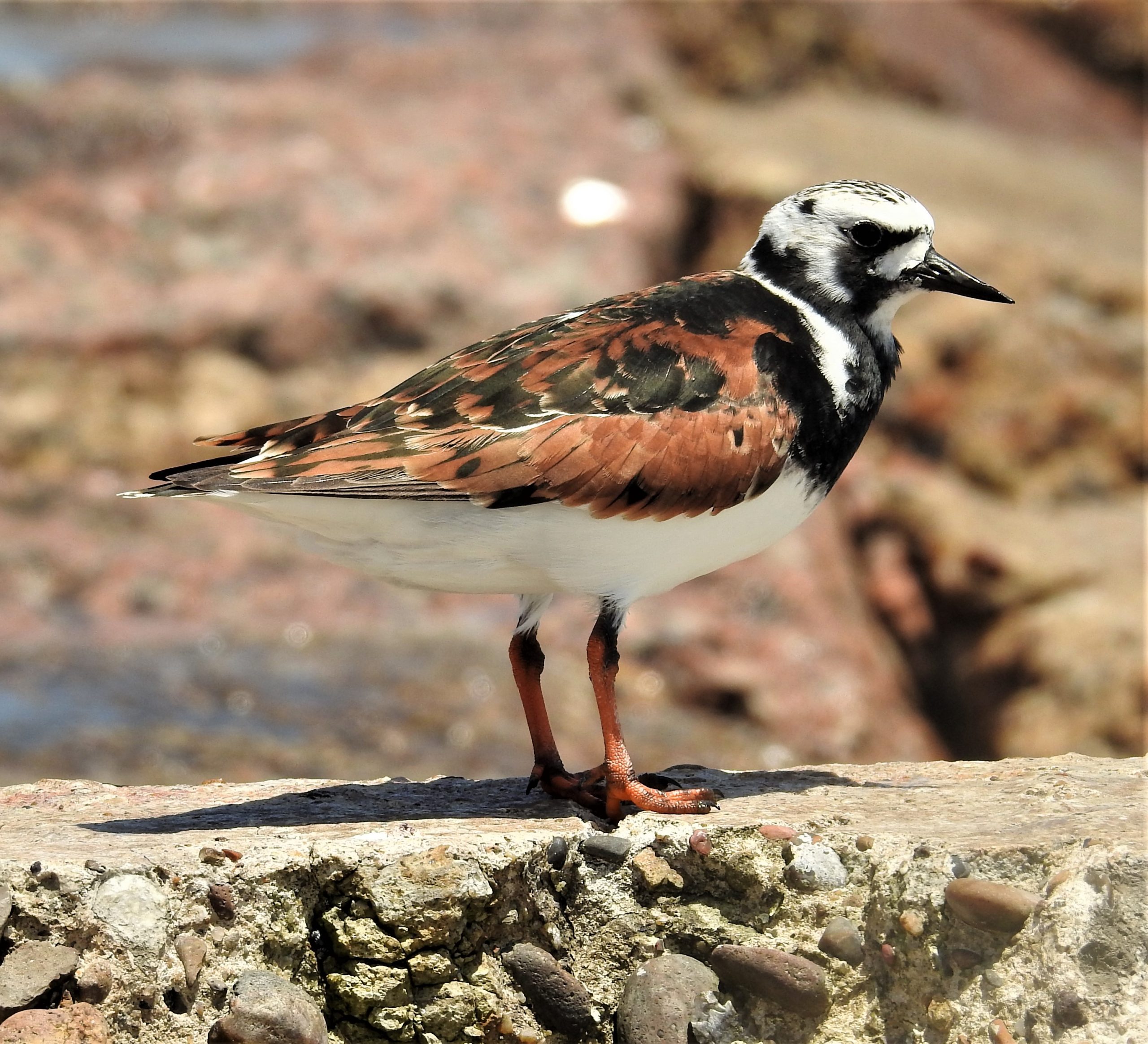by M. Kathy Raines

This busy little fellow’s rust and black feathers blend so seamlessly with the quartz and feldspar crystals embedded in the granite of the jetties, one might miss the creature were it not for its bright orange legs, white underparts and dappled head.
Also, the ruddy turnstone—whose name denotes its habit of overturning stones and other items to locate food—is a whir of motion as it scampers along rocks searching for prey.
Reminiscent of a tortoiseshell cat, a male ruddy turnstone—especially vivid during breeding season— sports a velvety black bib and mask. A mixture of black and chestnut feathers adorns its back, and its white head appears sprinkled with chocolate chips.
Though turnstones breed in the Arctic, we may spot them running along our shores and jetties dressed in stunning calico, as sometimes, according to Javier Gonzalez, Naturalist Educator at South Padre Island Bird, Nature Center and Alligator Sanctuary, they, along with other seabirds, “are late in molting out of their breeding plumages, or they don’t molt out completely.” Females, juveniles and nonbreeding males wear similar, but muted colors.
Formerly classed with plovers, the ruddy turnstone (Arenaria interpres), along with its fellow genus member, the black turnstone, are members of the sandpiper family, Scolopacidae. Some dub this vivid seabird “calico back” or “checkered snipe”, while others call it “seaweed bird” from its habit of scouring seaweed for prey. Spanish speakers, also noting the turnstone’s habit of overturning rocks, call it vuevepiedras rojizo.
The ruddy turnstone breeds in coastal tundra of North America and Eurasia, and it winters along the coasts of every continent except Antarctica. Sometimes, a few turnstones, likely those unready to nest, remain here all year. Traveling as far as 6,500 miles, they migrate in groups of tens to hundreds, sometimes intermixed with shorebirds like red knots and sanderlings.

Turnstones love rocky areas, but also hunt along mudflats and beaches. Gonzalez sees them regularly at the birding center, “flipping shells and rocks with their strong bills to look for food under them.” Gonzalez noted that turnstones “can be quite tame and opportunistic as they try to snatch bits of fish and bait dropped by the fishermen.” He has also seen them “hanging around under an osprey’s perch to scavenge bits of fish” dropped by the raptor.
Opportunistic feeders, turnstones, particularly when breeding, consume insects—especially flies—spiders and berries. They eat fish and carrion—including its occupying parasites—and tear apart crabs, pry open bivalves, bang closed bills against snail and barnacle shells and puncture bird eggs.
After they have bred, ruddy turnstones show fidelity to both mates and nesting sites. Once they form a pair—after various ground and aerial displays—the male, twisting his body as he calls, creates various scrapes in the ground, none of which the female uses. She chooses the site and scrapes out a suitable nest, lining it slightly with leaves.
With Arctic summers so short, ruddy turnstones produce only one clutch of from two to four eggs, provided chicks survive. Downy, precocial hatchlings exit the nest, and parents shepherd them towards suitable food. Since females migrate before chicks fledge, males care for them until they fly at from 19 to 21 days. Most males then depart, and, shortly thereafter, juveniles migrate together, usually with one or two adult males.
Facilitating the turnstone’s finesse as a runner, digger and climber are short, sturdy legs and back toes with no webbing, which are flattened, slightly spiny and cushioned, with curved toenails, along with an especially small hind toe. This equipment provides leverage as the bird probes for prey and enables it to balance itself on rocks and mud, chase down swift fiddler crabs and excavate the eggs of horseshoe crabs.

A variety of rattling calls allows ruddy turnstones to maintain contact, attract mates, defend turf and alert others to predators like ravens, foxes and some gulls. Males may jab, strike with feet or pursue a foe, but, like most creatures, they avoid perilous battles.
While not endangered, ruddy turnstone numbers, according to the North American Bird Conservation Initiative (NABCI), “ have fallen by 80% since 1974”, and 17 states have designated them “a species of greatest conservation need.” The usual suspects—pesticides, toxic chemicals and degraded habitat—are likely culprits, as well as warming Arctic temperatures and declines in suitable prey.

